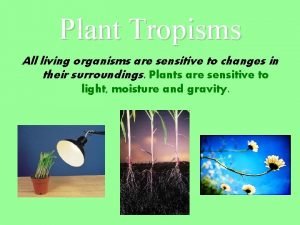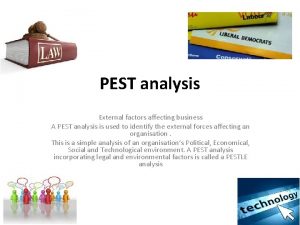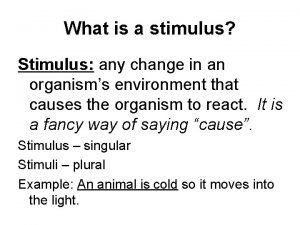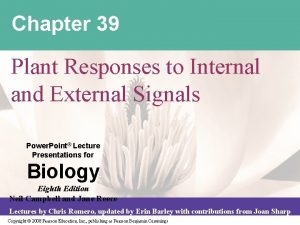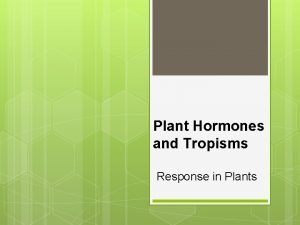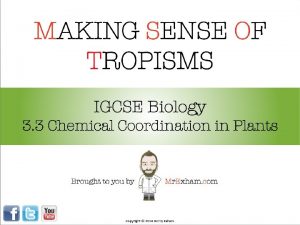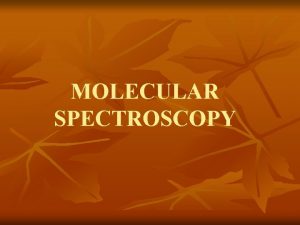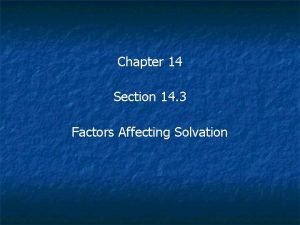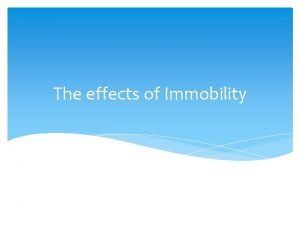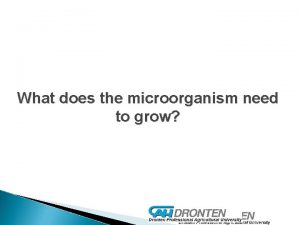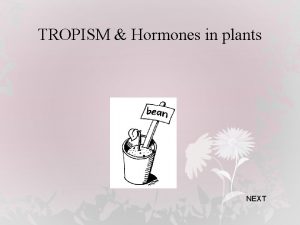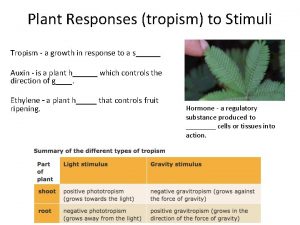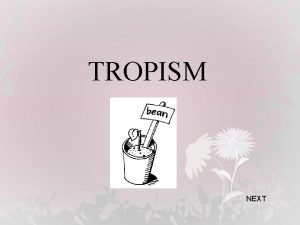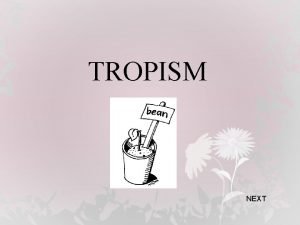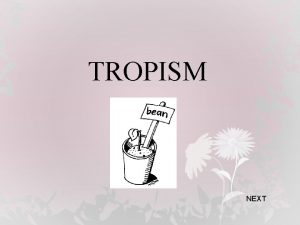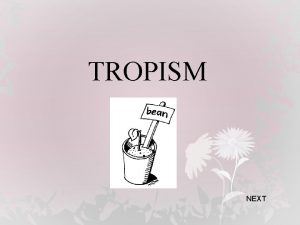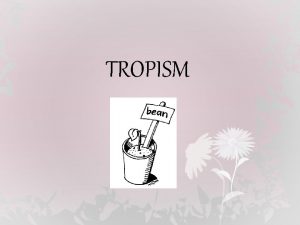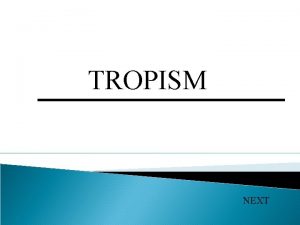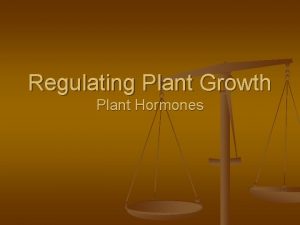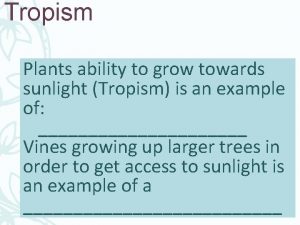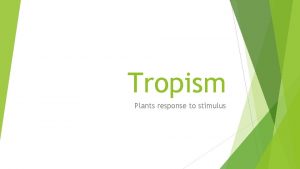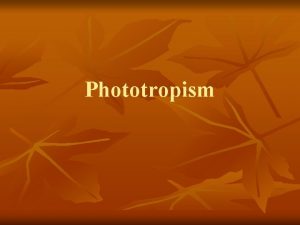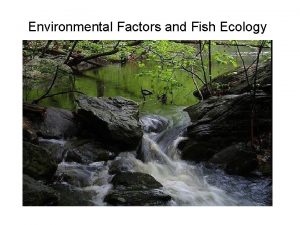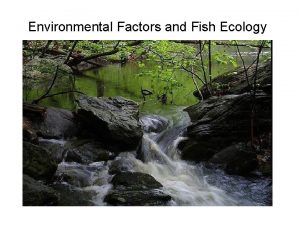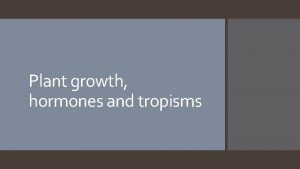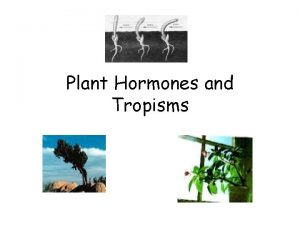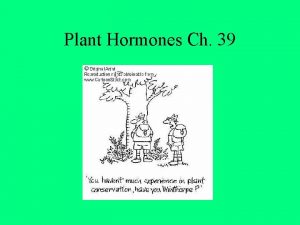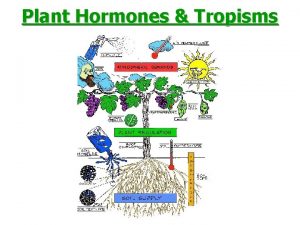Environmental Factors Tropism and Plant Hormones Affecting Plant
























- Slides: 24

Environmental Factors, Tropism and Plant Hormones Affecting Plant Growth Learning Goal: I will be able to explain the 4 environmental factors that affect plant growth, the 3 types of tropism, and the 5 types of plant hormones

Factors Affecting Plant Growth Light Nutrients Temperature Soil

Light Intensity Etiolated - the condition of a plant when grown in the absence of light elongated stems with small, pale leaves

Light Duration & Photoperiodism: A plant’s response to changing day length, usually so they will flower at precisely the right time of year. Question: What is the right time of year?

Types of Plants regarding Photoperiodism • Short-day plants (< 12 hour days) Ex. Strawberries • Long-day plants (> 12 hour days) Ex. Sunflowers • Neutral-day plants (not affected by day length) Ex. Beans How can humans alter this?

Nutrients • Macronutrients: needed in large amounts Some can be absorbed as gases in atmosphere or water (ex. C, H, O) • Micronutrients: needed in small amounts B, Cl, Cu, Fe, Mn, Mo, Ni, Zn

Main Macronutrients in Fertilizer Plant Nutrient Type Visual symptoms Deficiency Light green to yellow appearance of leaves, especially older leaves; stunted growth; poor fruit development. Excess Dark green foliage which may be susceptible to lodging, drought, disease and insect invasion. Fruit and seed crops may fail to yield. Deficiency Leaves may develop purple coloration; stunted plant growth and delay in plant development. Excess phosphorus may cause micronutrient deficiencies, especially iron or zinc. Deficiency Older leaves turn yellow initially around margins and die; irregular fruit development. Excess potassium may cause deficiencies in magnesium and possibly calcium. Nitrogen Phosphorus Potassium

Temperature Using what you already know about stoma control, how does temperature affect plant growth?

Soil Serves three purposes: 1) Provides anchor for roots 2) Retains water (and dissolved nutrients) 3) Provides the root with air (roots can’t photosynthesis, but still grow, so they need oxygen and the sugar for cellular respiration)

Soil SAND CLAY Humus Does not hold much water Holds too much water Partially decomposed remains of organisms with lots of nutrients (particularly N) *p. H of soil (really the p. H of the water in the soil) should be slightly less than neutral (p. H 7). How do humans affect p. H?

Soil, & Nitrogen Fixing Bacteria Some plants can turn unusable forms of nitrogen into the useful type needed as a nutrient in plants. This is because they have nitrogen fixing bacteria in the nodules of their roots. Ex. Alfalfa What is an organic alternative to adding fertilizers that farmers can use?

Tropism • the growth responses of plants to their environment • a plant's directional growth response to a physical stimulus • the growth of plants in response to external stimuli such as light, gravity, or contact

Tropism • positive tropism: when the plant grows toward the stimulus • negative tropism: when the plant grows away from the stimulus

Types of Tropism 1. phototropism – light 2. gravitropism – gravity 3. thigmotropism - touch

Phototropism • plant's response to light • positive phototropism - turns toward light (stem and leaves) • negative phototropism away from light (roots)

Gravitropism • plant's response to gravity • positive gravitropism - grows toward the pull of gravity (roots) • negative gravitropism - grows away from the pull of gravity ( stem and leaves)

Gravitropism

Thigmotropism • plant's response to touch • positive thigmotropism - grows toward touch • negative thigmotropism - grows away from touch

Thigmotropism

Plant Growth Hormones and Regulators 5 Types: Auxins Gibberelins Cytokinins Ethylene Abscisic acid

Auxins & Gibberellins & Cytokinins Both Auxins & Gibberellins induce cell elongation in many tissues The growth of shoots and roots is controlled by auxins. These chemicals are produced in the tips of the shoots and roots. Gibberellins also play a role in flowering and fruit production Cytokinins promote cell division

Ethylene is a plant hormone that controls fruit ripening. It can be sprayed on unripe fruit to speed up ripening. Some fruit, such as bananas, actually produce a large amount of ethylene, which can cause other nearby fruits to ripen.

Abscisic Acid Inhibits growth and promotes dormancy Induces stoma to close during water stress

Environmental Factors, Tropism and Plant Hormones Affecting Plant Growth Learning Goal: I will be able to explain the 4 environmental factors that affect plant growth, the 3 types of tropism, and the 5 types of plant hormones
 Which tropisms are best illustrated?
Which tropisms are best illustrated? Social factors of tesco
Social factors of tesco What three factors influence communication choices
What three factors influence communication choices What are the factors affecting plant layout
What are the factors affecting plant layout Tropism
Tropism Plant hormones and responses
Plant hormones and responses Plant hormones and responses
Plant hormones and responses Tropism in plants
Tropism in plants Henry exham
Henry exham Types of tropism
Types of tropism Cytokinin function
Cytokinin function Plant hormones
Plant hormones Local factors of wound healing
Local factors of wound healing Factors affecting oxygenation slideshare
Factors affecting oxygenation slideshare Factors affecting width and intensity of spectral lines
Factors affecting width and intensity of spectral lines 3 factors that affect solvation
3 factors that affect solvation Wages fund theory
Wages fund theory Factors affecting mobility and immobility
Factors affecting mobility and immobility Split half method of reliability
Split half method of reliability Mh 605
Mh 605 What factors affect the weather
What factors affect the weather Factors affecting microbial growth in food
Factors affecting microbial growth in food Lava plateau diagram
Lava plateau diagram Factor affecting volcanic eruption
Factor affecting volcanic eruption Factors affecting carburetion
Factors affecting carburetion
